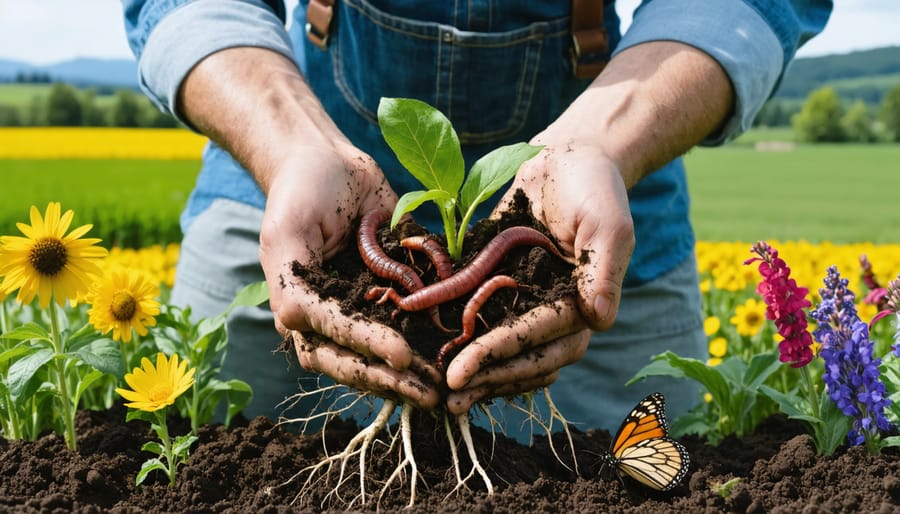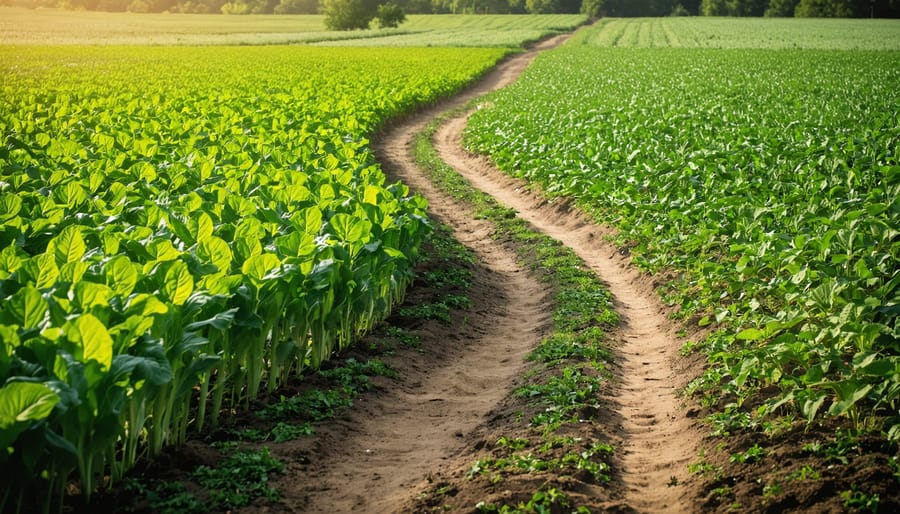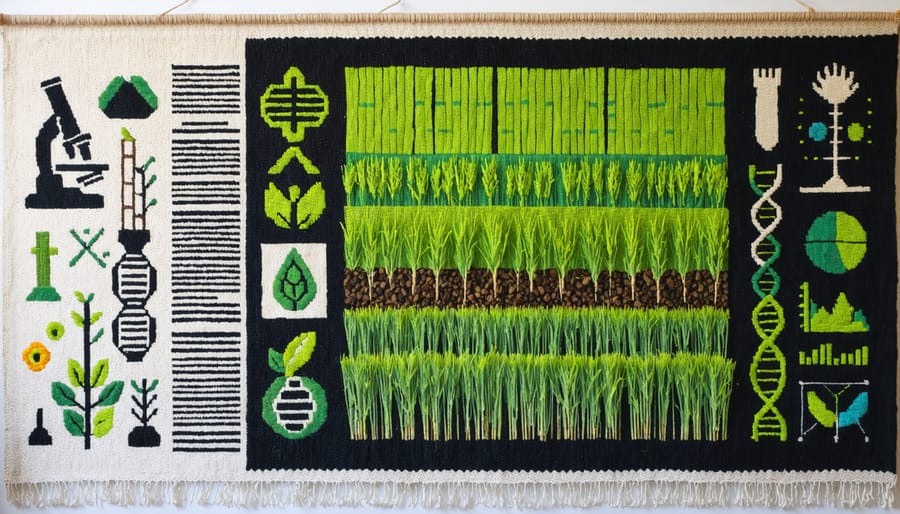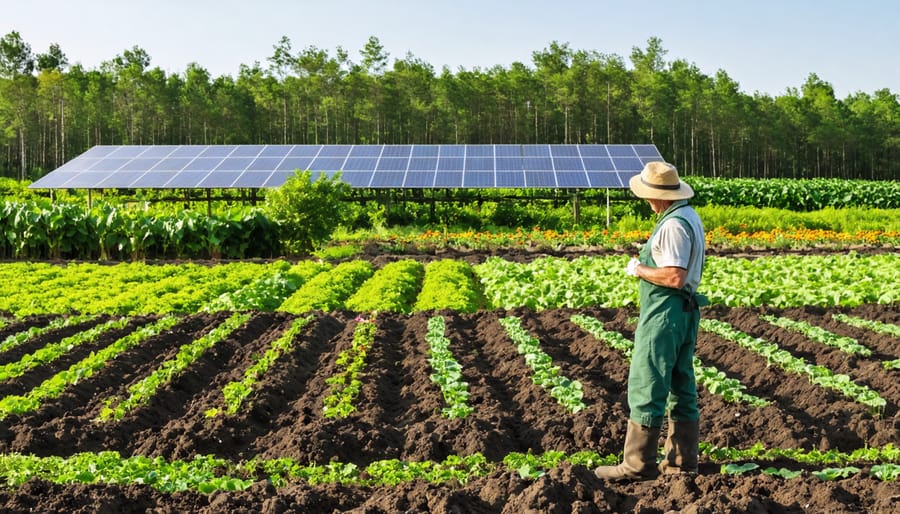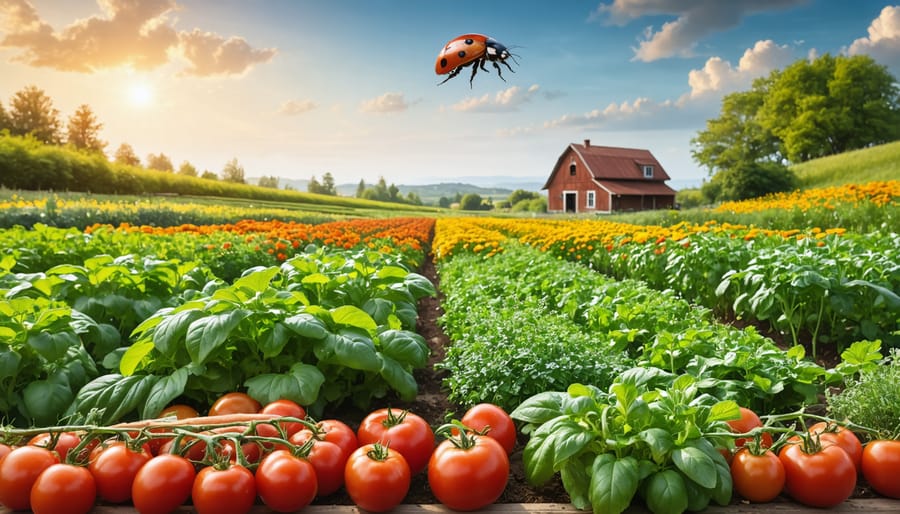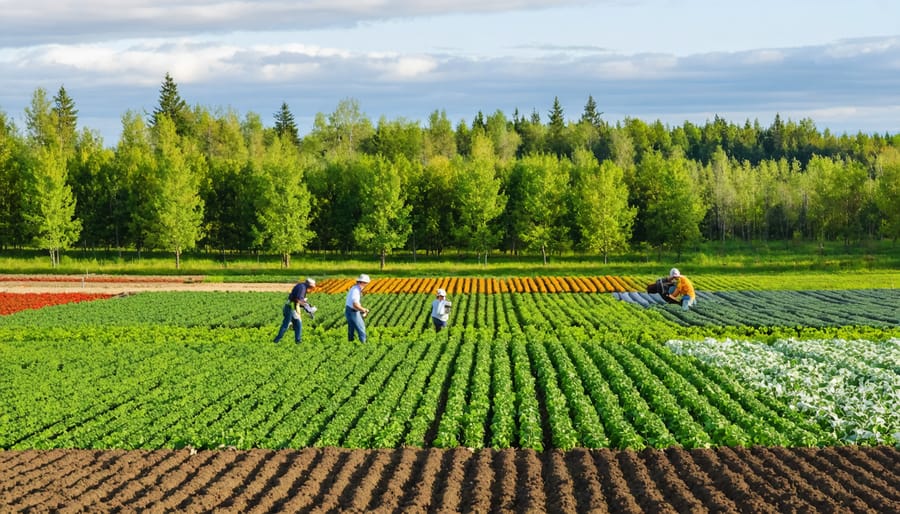Discover the transformative power of Regenerative Organic Certified agriculture – a holistic approach that goes beyond sustainability to actively heal ecosystems, empower farmers, and nourish communities. This innovative certification program combines the best of regenerative organic agriculture practices, focusing on soil health, animal welfare, and social fairness. For Canadian growers, especially those in Alberta, embracing Regenerative Organic Certified methods offers a path to enhanced resilience, profitability, and connection with conscious consumers seeking products that align with their values. Join the regenerative revolution and discover how this powerful approach can transform your farm, your community, and the future of agriculture in Canada.
What is Regenerative Organic Agriculture?
Soil Health
Regenerative organic practices prioritize soil health and fertility, recognizing that healthy soil is the foundation of a thriving agricultural system. By minimizing tillage, farmers reduce soil disturbance, allowing beneficial microorganisms to flourish and improve soil structure. Cover cropping protects the soil from erosion, adds organic matter, and enhances nutrient cycling. Composting and applying organic amendments, such as manure or green waste, further enrich the soil with essential nutrients. Crop rotation and intercropping promote biodiversity, break pest and disease cycles, and improve soil fertility through nitrogen fixation and nutrient exchange. These practices work together to build soil organic matter, increase water retention, and support a diverse ecosystem of beneficial organisms. By investing in soil health, regenerative organic farmers in Alberta and across Canada are creating a resilient and productive agricultural landscape that can sustain future generations.
Biodiversity
Biodiversity is a cornerstone of healthy, thriving ecosystems, and regenerative organic agriculture recognizes its vital importance. By promoting practices that support diverse plant and animal life, regenerative farming helps maintain the delicate balance of nature. This approach encourages the cultivation of a wide variety of crops, which not only improves soil health but also provides habitats for beneficial insects, pollinators, and wildlife. Additionally, regenerative organic practices like cover cropping and reduced tillage help protect and nurture the intricate web of soil microorganisms, which play a crucial role in nutrient cycling and plant growth. By embracing biodiversity, regenerative organic farmers in Canada, particularly in the Alberta region, are not only enhancing the resilience of their own land but also contributing to the preservation of our planet’s rich tapestry of life. Through their dedication to these principles, they serve as an inspiration to others in the agricultural community and beyond.
The Regenerative Organic Certified Program
ROC Pillars
The Regenerative Organic Certified (ROC) program is built upon three core pillars: soil health, animal welfare, and social fairness. These pillars work in harmony to create a holistic approach to agriculture that benefits the environment, farmers, and communities.
Soil health is the foundation of regenerative organic farming. By implementing practices such as cover cropping, composting, and reduced tillage, farmers can improve soil structure, increase organic matter, and enhance nutrient cycling. These practices not only lead to healthier, more resilient crops but also help to sequester carbon and mitigate the effects of climate change.
Animal welfare is another crucial aspect of ROC. Farmers must provide their animals with ample space to roam, access to the outdoors, and a diet that meets their natural needs. This approach not only ensures the well-being of the animals but also contributes to healthier ecosystems and higher-quality products.
Finally, social fairness is an integral part of the ROC program. Farmers must provide fair wages, safe working conditions, and opportunities for growth and development to their employees. By prioritizing the well-being of their workers, regenerative organic farmers foster a sense of community and contribute to the long-term sustainability of their operations.
Together, these three pillars create a comprehensive framework for regenerative organic agriculture that benefits the land, animals, and people involved in the farming process.
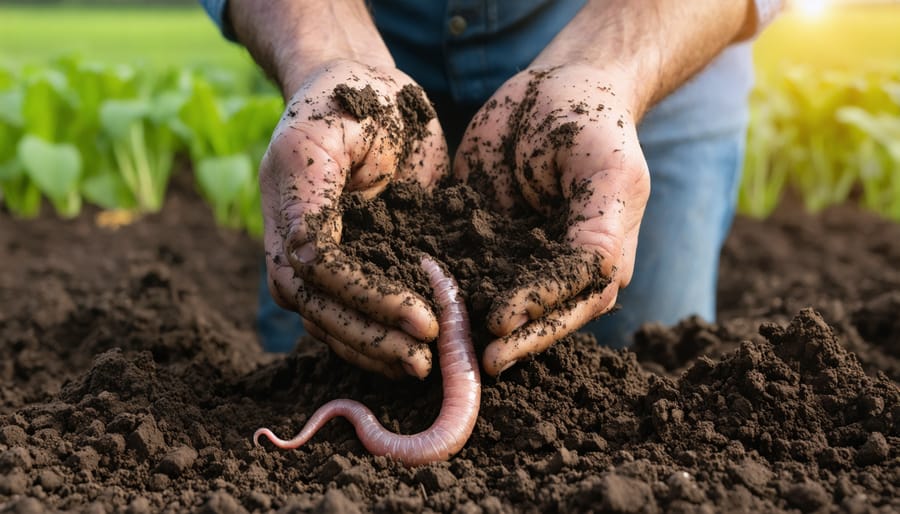
Certification Levels
The Regenerative Organic Certified program offers three certification levels: Bronze, Silver, and Gold. Each level has increasingly stringent criteria, allowing farmers to progress in their regenerative organic journey. The Bronze level requires meeting baseline standards for soil health, animal welfare, and social fairness. Farmers must use practices like cover cropping, composting, and rotational grazing. For Silver certification, additional criteria include more advanced soil conservation measures, such as reduced tillage and increased biodiversity. Animal welfare standards are higher, with access to pasture and space requirements. Fair labor practices and community engagement are also assessed. The Gold level represents the highest achievement, with rigorous requirements for soil organic matter, water conservation, and habitat restoration. Animals must be raised in their natural environment, and workers must receive living wages and benefits. Achieving each level showcases a farmer’s dedication to regenerative organic principles and helps build consumer trust in their products. By progressing through the levels, Canadian farmers can demonstrate leadership in sustainable agriculture and contribute to a healthier future for their land and communities.
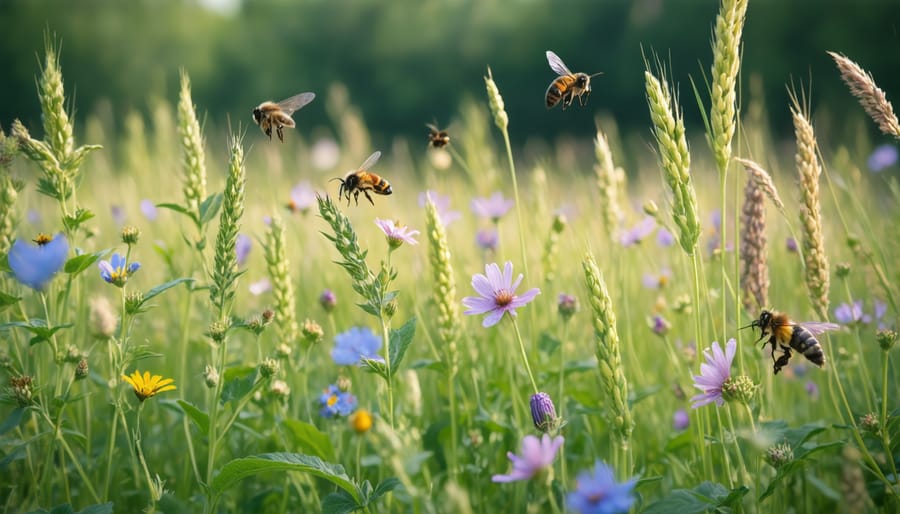
Benefits for Canadian Farmers
Market Differentiation
Regenerative Organic Certification (ROC) offers a unique opportunity for Canadian farmers to differentiate their products in the market. By adhering to the rigorous standards set by ROC, farmers can demonstrate their commitment to sustainable and ethical practices, which resonates with environmentally conscious consumers. ROC-certified products command premium prices, as buyers are willing to pay more for goods that align with their values. This certification opens doors to new markets, such as specialty food stores and farm-to-table restaurants that prioritize sustainably grown ingredients. Moreover, ROC farmers can tap into the growing demand for organic products in Canada, which has seen a steady increase in recent years. By standing out in the market with ROC certification, farmers can improve their financial sustainability while contributing to the health of their land and communities.
Resilience
Regenerative organic practices enhance farm resilience by building healthier soils that are better equipped to withstand climate change impacts like drought, floods, and extreme weather events. By prioritizing soil health, regenerative organic farmers create more resilient ecosystems that can bounce back from challenges and sustain productivity over time. Practices such as cover cropping, crop rotation, and reduced tillage help to improve soil structure, water retention, and nutrient cycling, leading to more robust and adaptable agricultural systems. Additionally, regenerative organic practices foster biodiversity on the farm, which can help to mitigate pest and disease pressures, reducing the need for chemical interventions. By working with nature and supporting the inherent resilience of the land, regenerative organic farmers in Canada, including those in the Alberta region, are better positioned to navigate the uncertainties of a changing climate while maintaining the long-term viability of their operations.
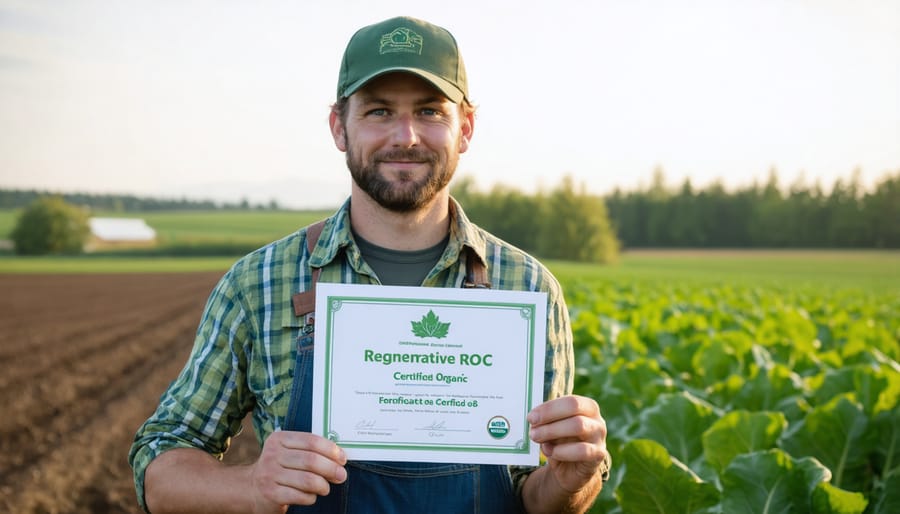
Case Studies
Alfalfa Meadows Farm in Alberta is a shining example of regenerative organic practices in action. After transitioning to regenerative organic methods, the farm has seen a significant increase in soil health, biodiversity, and crop yields. By implementing cover cropping, crop rotation, and composting, Alfalfa Meadows has reduced its reliance on synthetic inputs while enhancing farm resilience. The farm’s commitment to animal welfare and social fairness has also contributed to its successful certification.
Another inspiring case study is Green Acres Organic Farm in Saskatchewan. This family-run operation has embraced regenerative organic practices for over a decade, focusing on building healthy soil and fostering a diverse ecosystem. Through the use of no-till farming, agroforestry, and integrated pest management, Green Acres has achieved remarkable results in terms of soil carbon sequestration, water retention, and pest control. The farm’s dedication to regenerative organic practices has not only earned them certification but also positioned them as leaders in the Canadian sustainable agriculture community.
Conclusion
In conclusion, Regenerative Organic Certified represents a significant step forward in promoting sustainable agriculture practices in Canada. By focusing on soil health, animal welfare, and social fairness, ROC offers a comprehensive approach to farming that benefits both the environment and local communities. As Canadian farmers continue to face challenges such as climate change and market pressures, adopting regenerative organic practices can help build resilience and ensure long-term success. The case studies and expert insights provided in this article demonstrate the tangible benefits of pursuing ROC certification, from improved soil fertility to increased profitability. As the demand for sustainably produced food continues to grow, Canadian farmers who embrace regenerative organic agriculture will be well-positioned to meet the needs of consumers while preserving our precious agricultural resources for future generations. We encourage all farmers to explore the possibilities of ROC and consider how these practices can be implemented on their own operations.

